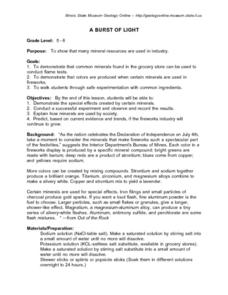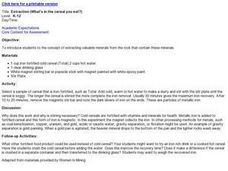Curated OER
A Burst of Light
Students discover the many uses of minerals in industry. They use minerals to conduct flame tests and to demostrate color. They practice safety tips in the lab.
Curated OER
Tommyknockers
Students explore the folklore of Tommyknockers. They discuss why the Tommyknockers were important to miners. Students make a favorite snack of the Tommyknockers, Cornish pastries.
Curated OER
Polishing the Petoskey
Students select a stone and polish it. Throughout the process they demonstrate an understanding of rocks and fossil formation.
Curated OER
Building Up, Breaking Down
Students explore their school building and examine the rocks it is made of. They discover how rocks become building materials and participate in a variety of activities surrounding this subject.
Curated OER
Extraction (What's in the cereal you eat?)
Students conduct an investigation with cereal that simulates the extraction of minerals from rock. They mix iron fortified cereal until the iron is extracted and shows on a magnetic stick that is painted white.
Curated OER
Mining and Land Reclamation - A Classroom Simulation
Students simulate mining mineral resources using cookies. In this earth science lesson, students analyze the cost and profits in mining. They write a lab report about the activity.
Curated OER
Finding the Ages of Rocks and Fossils
Young scholars practice dating fossils. They learn the concept of "deep time"--that earth was formed billions of years ago. They experience excellent hand-outs and virtual age tutorial links.
Curated OER
Mineral Munch
Second graders explore the sodium content in foods they eat. After observing a table setting, 2nd graders then identify items made from rock. They taste low sodium crackers and compare them to regular crackers. Students discuss the...
Curated OER
The Formation of Resources
For this rock worksheet, students review the three types of rocks and their distinguishing characteristics. This worksheet has 10 matching and 10 short answer questions.
Curated OER
Fossil Fuels vs. Alternative Fueling Systems
Fourth graders brainstorm the differences between the fossil fuels that people use in their transportation now and what they could use to minimize greenhouse gas emissions. They use a variety of techniques from webquests to writing...
Curated OER
Grow an Alum Crystal
What an exciting lab experiment to conduct with your high school chemistry class! Crystals are formed naturally in the environment. However, allow your blossoming chemists to create their own unique crystals using alum and water. You may...
Curated OER
Exploring Caves
Students explain why many caves have become National Parks. They determine that caves provide shelter from enemies, and from bad weather in the summer or the winter, and provide certain mineral resources. They discover that ancient art...
Curated OER
Quartz
In this quartz activity, students read about the chemical structure and properties of quartz and its commercial applications. Then, students complete 7 short answer questions.
Curated OER
Shake, Rattle and Roll
Students compare the weathering of different-sized materials. Comparisons are made and data analyzed to reach conclusions about the process of weathering. Applications can be made for the higher grades.
Curated OER
The Soil Chain
Fourth graders show the needs of plants met by soil. In this Science lesson, 4th graders detail the components of soil and determine which are living or once living and non-living. Students determine the needs of plant growth that are...
Curated OER
Using the Software Program "Kid-Pix"
Students create a slideshow using the software program Kid-Pix. They use the differences in rocks and minerals for their presentation. They also demonstrate different ways to import and save pictures using the program.
Curated OER
Reopen: A Study of Five Closed Mines
Students analyze data to determine which of the fived closed mines would be beneficial to have reopen. They acquire knowledge of rocks and minerals in the area to give reasons why that mine should open again. Students gain knowledge in...
Curated OER
Sand Hunt
In this earth science worksheet, students identify and locate various rocks and minerals listed on the sheet. Then they describe each one in the boxes given.
Curated OER
BOWEN'S REACTION SERIES
Learners research Bowen's Reaction Series and recreate the process in an experiment which details the crystallization sequence of minerals that can be observed in nature.
Curated OER
Surface Water and Groundwater
Students examine distribution of water and minerals. In this surface and groundwater instructional activity, students conduct an experiment with fresh and salt water making hypothesis and drawing conclusions about minerals.
Curated OER
Fossil Inferences
Fourth graders use their knowledge about fossils to arrange fossil pictures in sequence from oldest to youngest. They explain how fossils can be used to make inferences about past life, climate, geology, and environments and discover...
Curated OER
Rock Eater
Pupils examine the effects of acid rain by
performing a simulation experiment. They also view the
effects of acid rain and erosion on the reservation and record observations in a science log.
Other popular searches
- Rocks and Minerals Worksheet
- Rocks and Minerals Crossword
- Geology Rocks and Minerals
- Rocks and Minerals Word Search
- Rocks and Minerals Flowchart
- Minerals Rocks Soils
- Notes Rocks and Minerals
- Minerals and Rocks
- Abc Rocks and Minerals
- Science Rocks and Minerals
- Comparing Rocks and Minerals
- Sedimentary Rocks Minerals

























